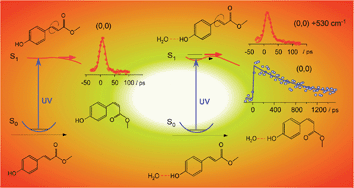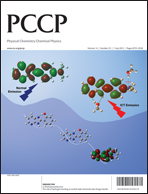The lifetimes of methyl 4-hydroxycinnamate (OMpCA) and its mono-hydrated complex (OMpCA–H2O) in the S1 state have been measured by picosecond pump–probe spectroscopy in a supersonic beam. For OMpCA, the lifetime of the S1–S0 origin is 8–9 ps. On the other hand, the lifetime of the OMpCA–H2O complex at the origin is 930 ps, which is ∼100 times longer than that of OMpCA. Furthermore, in the complex the S1 lifetime shows rapid decrease at an energy of ∼200 cm−1 above the origin and finally becomes as short as 9 ps at ∼500 cm−1. Theoretical calculations with a symmetry-adapted cluster-configuration interaction (SAC-CI) method suggest that the observed lifetime behavior of the two species is described by nonradiative decay dynamics involving trans → cis isomerization. That is both OMpCA and OMpCA–H2O in the S1 state decay due to the trans → cis isomerization, and the large difference of the lifetimes between them is due to the difference of the isomerization potential energy curve. In OMpCA, the trans → cis isomerization occurs smoothly without a barrier on the S1 surface, while in the OMpCA–H2O complex, there exists a barrier along the isomerization coordinate. The calculated barrier height of OMpCA–H2O is in good agreement with that observed experimentally.

You have access to this article
 Please wait while we load your content...
Something went wrong. Try again?
Please wait while we load your content...
Something went wrong. Try again?


 Please wait while we load your content...
Please wait while we load your content...